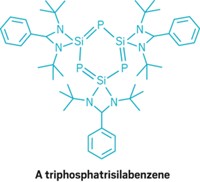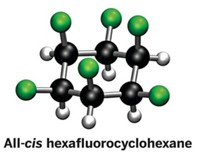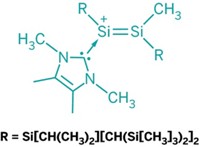Advertisement
Grab your lab coat. Let's get started
Welcome!
Welcome!
Create an account below to get 6 C&EN articles per month, receive newsletters and more - all free.
It seems this is your first time logging in online. Please enter the following information to continue.
As an ACS member you automatically get access to this site. All we need is few more details to create your reading experience.
Not you? Sign in with a different account.
Not you? Sign in with a different account.
ERROR 1
ERROR 1
ERROR 2
ERROR 2
ERROR 2
ERROR 2
ERROR 2
Password and Confirm password must match.
If you have an ACS member number, please enter it here so we can link this account to your membership. (optional)
ERROR 2
ACS values your privacy. By submitting your information, you are gaining access to C&EN and subscribing to our weekly newsletter. We use the information you provide to make your reading experience better, and we will never sell your data to third party members.
Synthesis
Elusive Pyramidanes Synthesized
Germanium- and tin-capped square pyramid molecules are the first examples of this class of polyhedral compounds
by Stephen K. Ritter
June 10, 2013
| A version of this story appeared in
Volume 91, Issue 23
As geometrically interesting molecules go, chemists have predicted that an all-carbon square pyramidal structure, called a pyramidane, would be a great synthetic target. If for no other reason, they could study the unusual bonding of its highly strained polyhedral framework. Pyramidane and its isomers have been thoroughly investigated via computational chemistry, but no one has been able to make a stable sample. Vladimir Ya. Lee and Akira Sekiguchi of the University of Tsukuba, in Japan, and their colleagues have now come close by preparing a couple of kissing cousins: carbon squares capped by germanium or tin, Ge[C4(Si[CH3]3)4] and Sn[C4(Si[CH3]3)4] (J. Am. Chem. Soc. 2013, DOI: 10.1021/ja403173e). The researchers made the compounds by coupling silyl-substituted cyclobutadiene dianion salts with germanium and tin dichloride dioxane complexes. It turns out that the properties of the pyramidal molecules, which lie between purely organic compounds and transition-metal compounds, could lead to practical applications, Sekiguchi says. Transition-metal complexes featuring π-bonded cyclic polyene ligands, such as the iron complex ferrocene with its cyclopentadienyl groups, helped revolutionize the field of transition-metal chemistry and catalysis, he notes. Sekiguchi envisions that the pyramidanes could further bolster the field by serving as precursors for new transition-metal cyclobutadiene complexes.





Join the conversation
Contact the reporter
Submit a Letter to the Editor for publication
Engage with us on Twitter